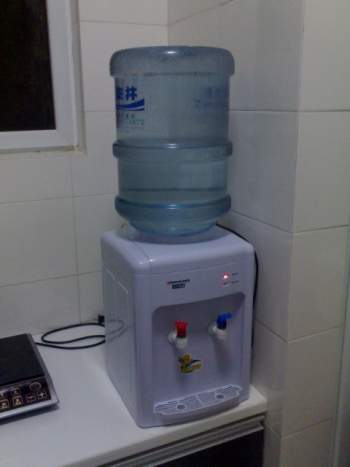 中文
中文
图片里有一个饮水机。
在中国到处都有:所有的办公室,商店,每个私人家里,处处户户。
你去买东西的时候,服务员一定会给你一杯水:冬天的时候给你热水,夏天给你冷水。
如果是你去逛很多商店的话,最后会出现有一点麻烦,因为哪里都有饮水机,但是可以使用的卫生间不多!
从图片可以看到有两个开关:一个是红色的,另外一个是蓝色的。
打开红色,热水出来;打开蓝色,冷水出来。
很简单!
当然可以混合热水和冷水得到最喜欢的温度。
那么如果我想喝室温水,怎么办?
最伶俐的读者一定已经发觉了,最基本的龙头都没有!
一定要使用水机的功能:不能把普通、粗俗的水直接捯出来!严重禁止的!
亲爱的西方读者们,你们放心吧!
有办法调节家里的背叛的水机!
像我家里一样:把插头拔掉!
pīnyīn
Túpiàn lǐ yǒu yí gè yǐnshuǐjí.
Zài zhóngguó dào chù dóu yǒu: suǒyǒu de bàngóngshì, shángdiàn, měigè sírén jiálǐ, chǔchùhùhù.
Nǐ qù mǎi dóngxí de shíhòu, fú wù yuán yí dìng huì gěi nǐ yí béi shuǐ: dóngtián de shíhòu gěi nǐ rè shuǐ, xiàtián gěi nǐ lěng shuǐ.
Rúguǒ shì nǐ qù guàng hěnduó shángdiàn de huà, zuì hòu huì chúxiàn yǒu yídiǎn máfán, yínwéi nǎlǐ dóu yǒu yǐnshuǐjí, dànshì kěyǐ shǐyòng de wèishéngjián bú duó!
Cóng túpiàn kěyǐ kàndào yǒu liǎnggè káiguán: yígè shì hóngsè de, lìngwài yígè shì lánsè de.
Dǎkái hóngsè, rèshuǐ chúlái; dǎkái lánsè, lěngshuǐ chúlái.
Hěn jiǎndán!
Dángrán kěyǐ hùnhé rèshuǐ hé lěngshuǐ dédào zuì xǐhuán de wéndù.
Nǎme rúguǒ wǒ xiǎng hé shìwén shuǐ, zěnmebàn?
Zuì línglì de dúzhě yídìng yǐjíng fájué le, zuì jíběn de lóngtóu dóu méi yǒu!
Yídìng yào shǐyòng shuǐjí de góngnéng: búnéng bǎ pǔtóng, cúsú de shuǐ zhíjié zhíjiē chūlai! Yánzhòng jìnzhǐ de!
Qìngài de xífáng dúzhě mén, nǐmén fàngxín ba!
Yǒu bànfǎ tiáojié jiálǐ de bèipàn de shuǐjí!
Xiàng wǒ jiá lǐ yíyàng: bǎ chátóu bádiào!
Italiano
Nella figura si può vedere un distributore dell’acqua potabile.
In Cina si trova letteralmente dovunque: in ogni ufficio, nei negozi, in tutte le case, dappertutto.
Quando si va a fare compere, gli inservienti ti portano sempre un bicchiere (di carta) d’acqua: calda d’inverno, fredda d’estate.
Il che può essere un minimo problematico quando si va a visitare parecchi negozi, in quanto è vero che l’acqua c’è dappertutto, ma di bagni adoperabili senza preoccupazioni non ce n’è poi così tanti!
In figura si vede come ci siano due manopole: rossa per acqua rovente, blu per acqua ghiacciata.
Molto semplice!
Chiaramente si può mischiare l’acqua calda e l’acqua fredda per ottenere ogni variazione di temperatura.
Ma se si volesse bere dell’acqua a temperatura ambiente?
I lettori più attenti avranno notato che manca il rubinetto più semplice!
Bisogna per forza utilizzare il servizio della macchinetta, non è ammissibile permettere a della normale e rozza acqua di uscire direttamente! Vietato!
Cari lettori occidentali, non preoccupatevi: almeno per la macchinetta di casa, c’è il modo di regolare la perfida macchinetta!
Basta fare come me, e staccare la spina!
English
The picture shows a water dispenser.
In China they are all over: offices, shops, in every house, everywhere.
When you go shopping, waiters always give you a (paper) cup of water: hot in winter, cool in summer.
This can be a little of a problem, since water is ubiquitous, but restrooms that can be used without too much worries are not that many.
In the picture can be seen two handles: red for hot water, blue for cold water.
So easy!
Obviously you can mix hot and cold water to obtain the temperature you want.
But… what if you want to drink water at room temperature?
The most attentive readers surely noticed that the simplest of the faucets is missing!
You must use the dispenser’s functionalities, is it not acceptable to let plain, coarse water to came out directly. It’s forbidden!
Dear western readers, don’t worry: at least for the home dispenser, there is a way to set up the mean machine!
Do like I did: unplug it!
notes
Attenzione a non confondere 拔 (bá) con 拨 (bō) che vuol dire un po’ di cose tra cui “comporre il numero sul telefono”.

